
Ukraine will receive first 42 F-16 fighters from Netherlands: Impact of F-16s on air power balance over Ukraine
Espreso offers an analysis of these aircraft, detailing Ukraine's negotiation process for their acquisition, and outlining how the deployment of F-16s could potentially change the situation on the frontline
How did Ukraine manage to get the F-16s?
As of September 2022, the prospect of supplying F-16 fighter jets to Ukraine seemed remote, if not improbable. General James Hecker, the commander of the US Air Force in Europe and Africa, indicated that Ukraine would get F-16s approximately 2-3 years following the necessary political decision.
Joe Biden's statements in January were not particularly encouraging for Ukrainians. Even following his visit to Kyiv, the US president continued to dismiss the likelihood of providing F-16s to Ukraine. This was the impression conveyed by his public declarations.
"There is no basis upon which there is a rationale, according to our military now, to provide F-16s. I am ruling it out for now," Biden said in the winter.
However, in early 2023, Ukrainian Foreign Minister Dmytro Kuleba openly stated that after reaching an agreement on the supply of Leopard tanks, the next step would be fighter jets. And in March, Western media reported that Ukrainian pilots had arrived in the United States to train on F-16 simulators.
Key decisions were made in May 2023. US President Joe Biden approved the training of Ukrainians on the F-16, and a few days later, at the 12th meeting of Ukraine's allies in the Ramstein format, it was decided to create an air coalition to train Ukrainian pilots.
On August 18, Dutch Deputy Prime Minister Wopke Hoekstra confirmed that on August 17, the United States had approved the shipment of F-16 multi-role fighter jets to Ukraine. Earlier, Danish Foreign Minister Lars Løkke Rasmussen confirmed that his country had received permission to send fighter jets to Ukraine.

Photo: Reuters
When will Ukraine receive the F-16s? Could they have been delivered earlier?
On August 17, Ukrainian Air Force spokesperson Yuriy Ihnat announced that Ukraine won't be able to get F-16 fighters from Western allies during the upcoming fall or winter. Therefore, the focus will be on bolstering air defense capabilities.
Earlier, the Ministry of Defense of Ukraine hoped to receive the first aircraft in the fall of 2023. In particular, this was stated by Defense Ministry adviser Yuriy Sak in a comment for the Washington Post.
"If we all pull our weight … and decisions are made quickly. I would estimate that at the end of September, early October, we could see the first F-16s flying in Ukrainian airspace," Sak said. The Pentagon has given roughly the same dates, noting that "the supply of F-16s to Ukraine could take several months."
The fighter jets were not delivered earlier because the Ukrainian Armed Forces had more important needs. At the Ramstein meeting, the Chairman of the Joint Chiefs of Staff, General Mark Milley, said that Ukraine's defense capabilities are being strengthened gradually. For example, 10 F-16 aircraft cost a billion dollars, and the same amount is spent on their supply and maintenance. Previously, the funds should have been used for more important needs of Ukraine.
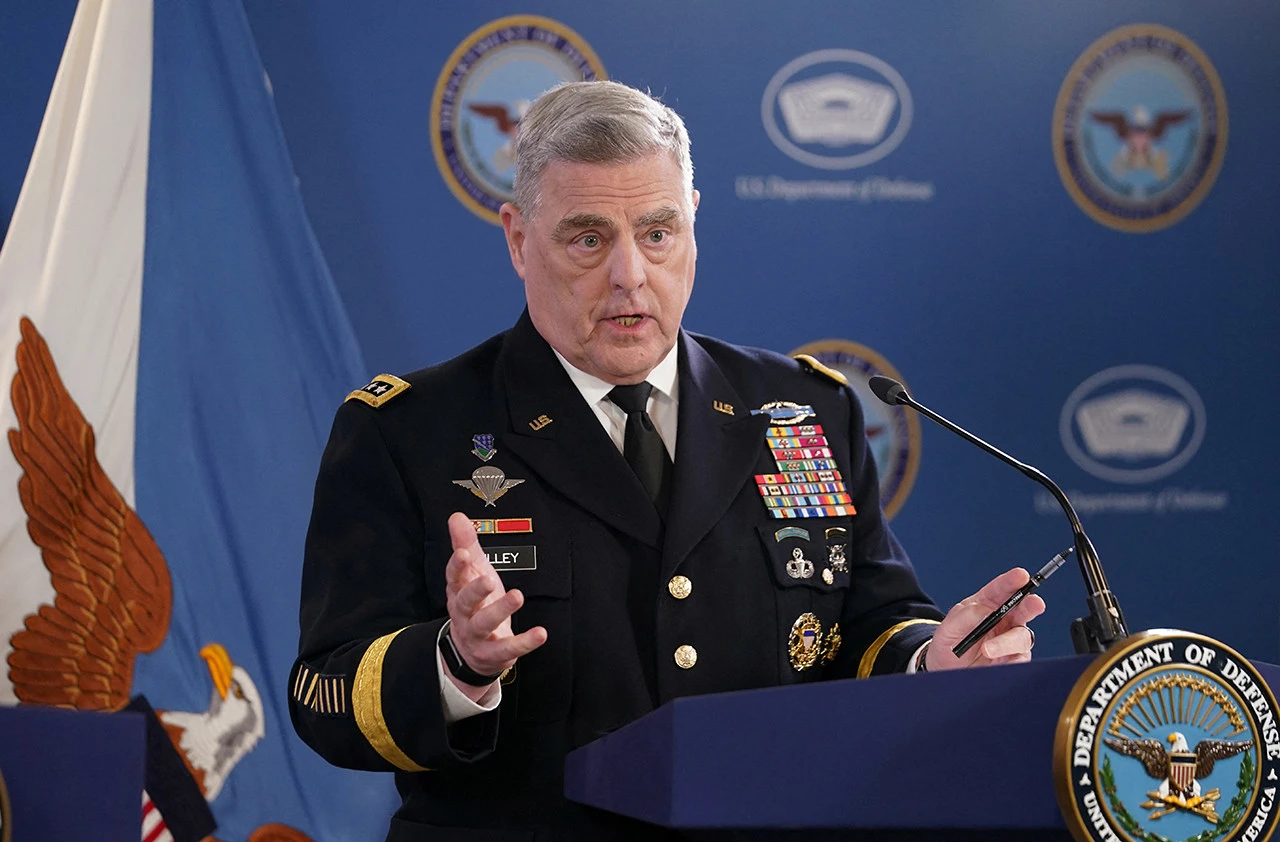
Photo: Reuters
Milley stated that if they had been discussing F-16s, which Ukraine had been requesting for a long time, there would not have been Bradley or Abrams. He noted that their approach involved gradual provision, with each package incorporating additional enhancements to enhance Ukraine's military capabilities.
What is an F-16 fighter jet and what are its technical characteristics?
The F-16 Fighting Falcon (also known as the Viper among pilots) is a single-engine light fighter developed by General Dynamics for the US Air Force. Today, in addition to the United States, 24 other countries use these fighters. The F-16 is the most mass-produced fourth-generation fighter jet: as of 2009, more than 4,400 aircraft were built, and in 2016, more than 2,500 of them were in service.
Originally conceived as a daytime fighter to secure air superiority, the F-16 has progressively transformed into an all-weather, multi-role aircraft. Notable attributes of this fighter jet encompass a frameless canopy for enhanced visibility, a side joystick facilitating maneuvering control, an ejection seat designed to tilt up to 30 degrees from vertical to mitigate pilot overload impact, and a fly-by-wire control system contributing to flight control stabilization.
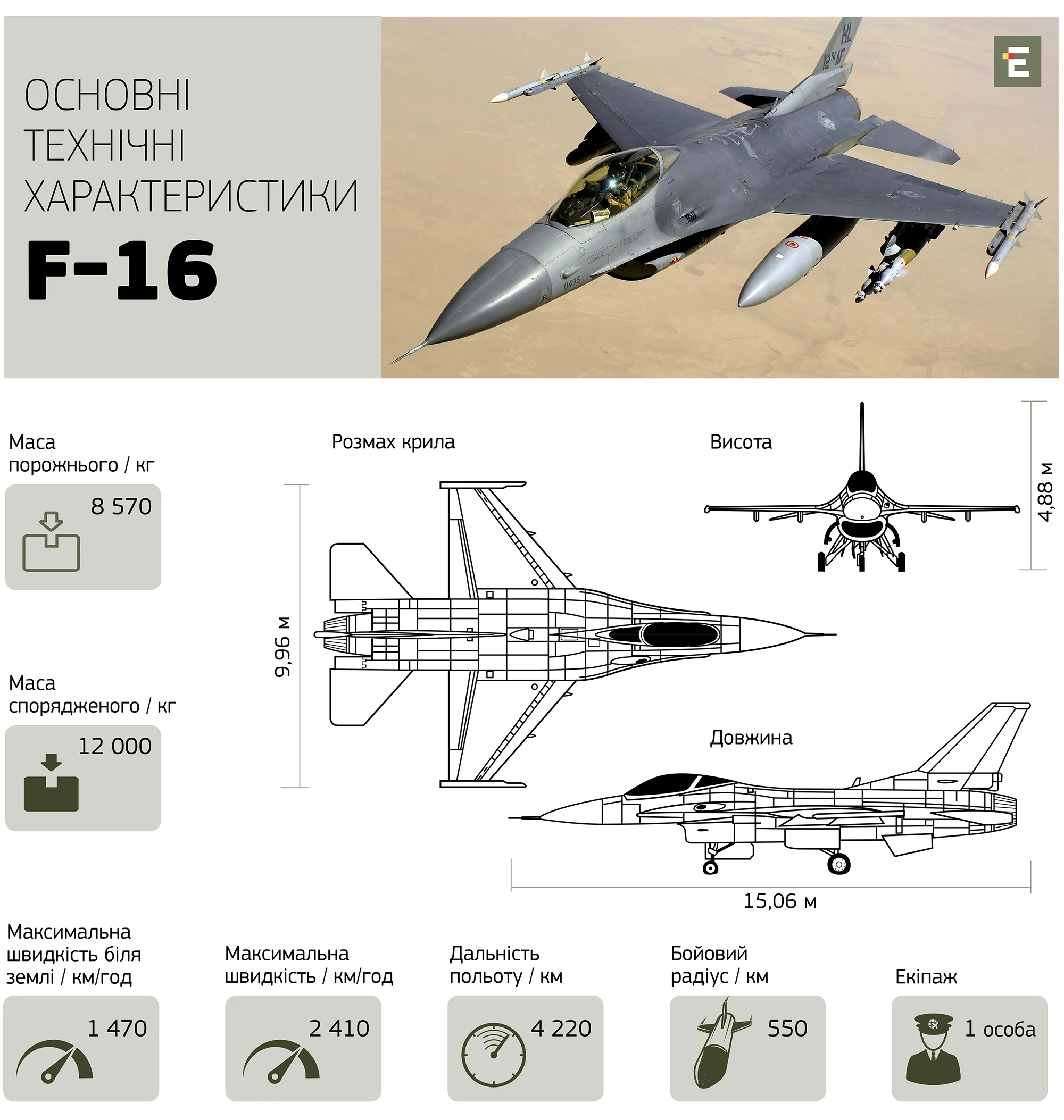
Main technical characteristics of the F-16:
-
length: 15.06 m;
-
height: 4,88 м;
-
wingspan: 9,96 м;
-
empty weight: 8570 kg
-
weight of the equipped aircraft: 12,000 kg
-
maximum speed: 2,410 km/h
-
maximum speed near the ground: 1,470 km/h
-
flight range: 4,220 km
-
combat radius: 550 km
-
crew: 1 person
The fighter jet is armed with a six-barrel General Electric M61-A-1 aircraft gun (6,000 rounds per minute, 511 rounds), up to six AIM-9L/M/P Sidewinder short-range guided missiles. In the fighter-bomber version, it can carry air-to-surface guided missiles, as well as guided bombs with laser and optoelectronic guidance systems, conventional bombs Mk.82, Mk.83 and Mk.84. The F-16ADF can carry the AIM-7 Sparrow medium-range air-to-air missile. It is possible to use air-to-surface missiles AGM-65A/B/D Maverick.
Are F-16s better than MiGs and Su?
Russian sources often publish comparative tables of fighter aircraft characteristics, which suggest that Su aircraft are no worse than F-16s. However, these tables compare parameters such as size or speed, which are not really decisive.
For example, a veteran of the Russian-Ukrainian war, Major Oleksiy Hetman, emphasizes that the Falcons are ahead of Russian fighter jets in many respects. The smaller size of the F-16 is its advantage. In addition, American fighter jets have a better radar system. That is, the F-16 will "see" Russian Sukhoi and MiGs at a greater distance than they can.
"The big difference between all Russian aircraft and the F-16 is that the F-16 is less visible to enemy radar systems and airborne radars because it has an effective reflective surface of only 1 square meter, while the MiG-29 has 29 square meters. That is, the F-16 is less visible. It also has an on-board radar that can see a hundred kilometers further than the enemy. And the missiles used by the F-16 are more long-range, flying 50-70 kilometers further than the missiles of the same MiG-29," the military analyst noted.
Hetman says that a possible air battle between a MiG-29 and an F-16 would simply not have started because the F-16 would have seen the enemy aircraft earlier and destroyed it.
Why does Ukraine need F-16s?
Lieutenant General Mykola Oleshchuk, Commander of the Air Force of the Ukrainian Armed Forces, spoke in detail about the importance of the American Vipers for Ukraine's defense. According to him, Russian aviation currently has a quantitative and technological advantage over Ukrainian aviation. Protecting the Ukrainian Armed Forces and civilians in the combat zone from enemy aircraft and helicopters will help save many lives.
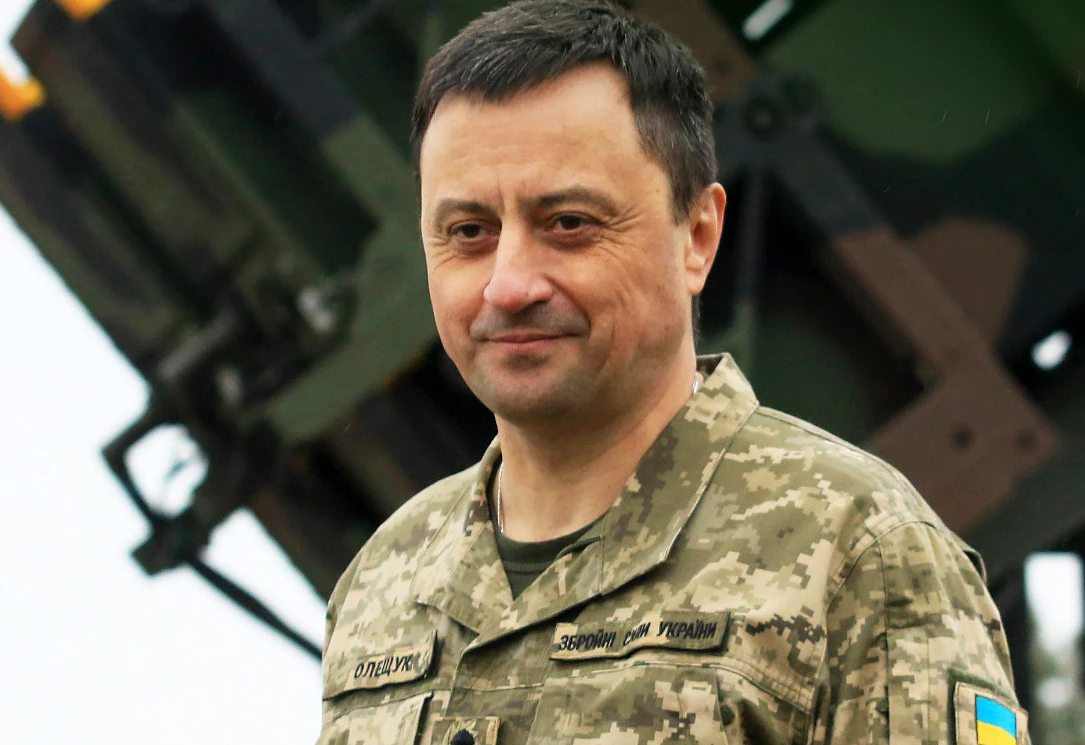
Lieutenant General Mykola Oleshchuk, Commander of the Air Force of the Ukrainian Armed Forces.
Photo: www.facebook.com/kpszsu
In addition, Oleshchuk writes that despite the effective work of Ukrainian air defense, it destroys about 75% of cruise missiles and attack drones, and the rest still reach their targets. Instead, F-16s can effectively destroy air threats at the borders, preventing missiles and drones from reaching Ukrainian cities. Also, the Falcons will allow Ukraine to effectively counteract guided bombs.
"The enemy is increasingly using 500 kg guided aerial bombs along the entire front line. There are signs of preparations for the massive use of 1,500 kg KABs! Russian planes do not enter the area of our air defense, remotely striking the front line and frontline cities. Civilians in the northern, southern, and eastern regions are suffering. The F-16s are armed with air-to-air missiles with a range of up to 180 kilometers. This will allow us to drive enemy aircraft away from our borders and the combat line, which minimizes the likelihood of using guided bombs and other airborne weapons," the Air Force commander noted.
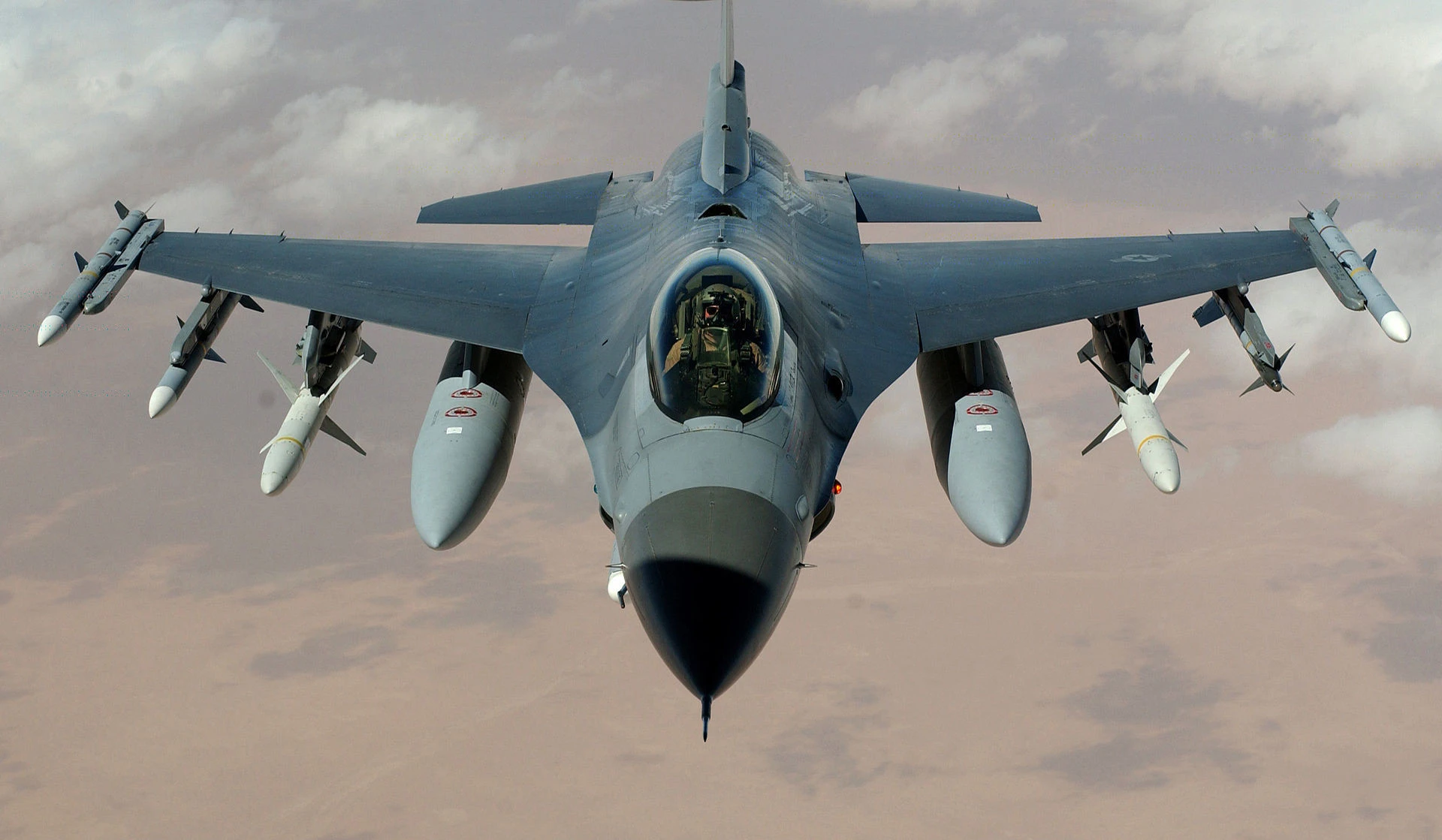
Photo: Getty Images
Also, according to Oleshchuk, the F-16 will help establish control over the Black Sea, "drive the entire enemy fleet either into ports or to the seabed."
How will the F-16 affect the war against Russia?
Western allies have consistently cautioned against viewing the fighter jets as a "silver bullet" capable of instantaneously transforming the situation in Ukraine's favor. For instance, Joe Biden underscored that F-16s may not be optimally effective in all scenarios.
"As for F-16s, they are not needed, for example, in Bakhmut. They will not bring any additional benefit there. Ukraine already has all the weapons it needs, including tanks. I do not think that F-16s will take part in combat operations now. A counteroffensive will begin in the near future, and if it is successful, then we will need to fight the Russians, who are based at a great distance, for which the range of the current tanks is not enough," the US president explained.
The fact that Ukraine does not plan to use American fighter jets during the summer counteroffensive was confirmed by Ukrainian Defense Minister Oleksii Reznikov. However, Air Force Commander Mykola Oleshchuk, for example, believes that the Falcons would be useful in the counteroffensive.
"The wide range of modern precision weapons of the F-16 will allow for precision strikes on Russian troops during counteroffensive operations. It is necessary to stop the enemy's attacks, gain air superiority, and destroy the enemy's supply routes for equipment, ammunition, and manpower. These tasks can be accomplished by the F-16!" the lieutenant general wrote.
Even 20-30 F-16s can give Ukraine complete air superiority, said military analyst Oleksiy Hetman. In his opinion, a few dozen of these aircraft are better than half a thousand MiGs. Military expert Serhiy Zgurets believes that F-16 fighter jets with long-range missiles in cooperation with AVACS will completely stop the flights of Russian Su-57s in Ukraine.
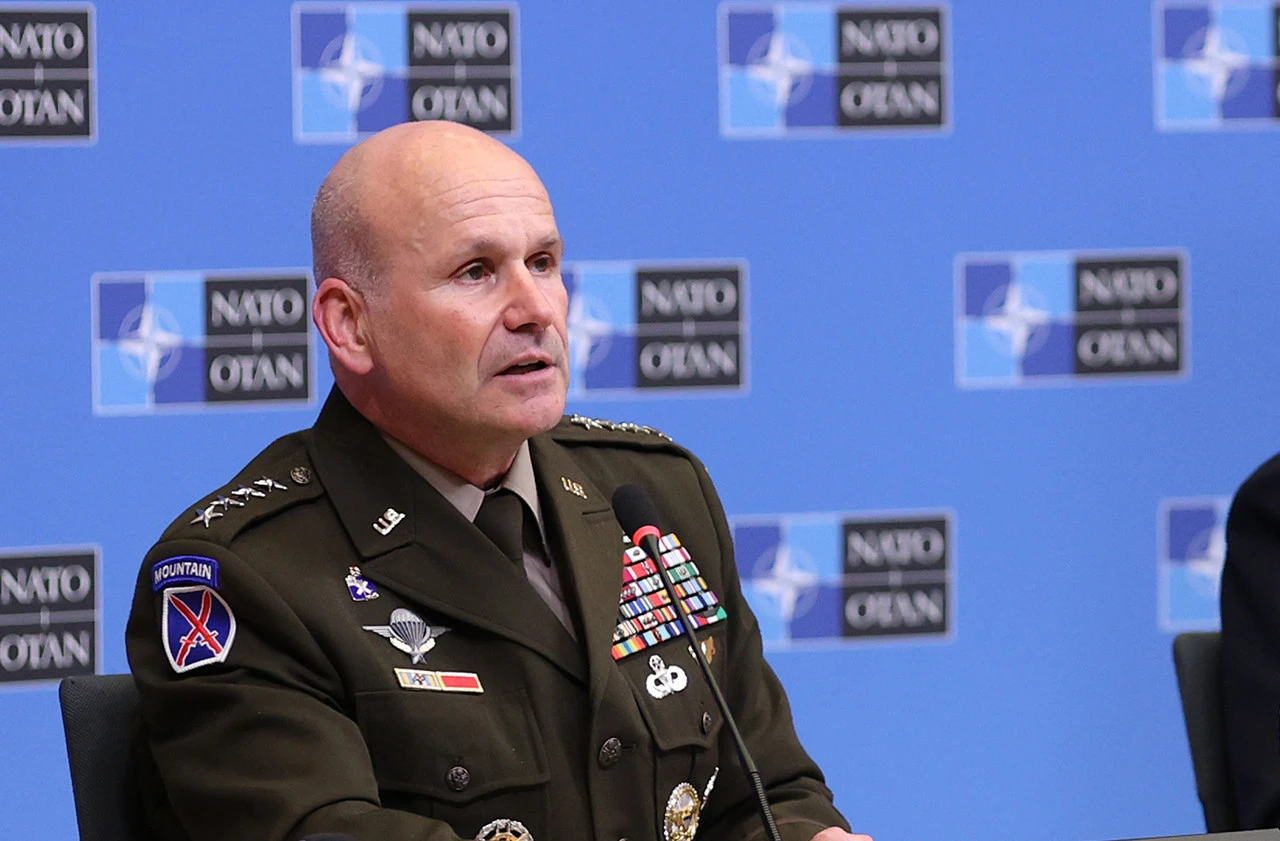
Commander of Allied Forces Europe, General Christopher Cavoli.
Photo: Getty Images
General Christopher Cavoli, Commander of NATO's Allied Forces Europe, made an even more categorical forecast. He said that providing Ukraine with F-16s and long-range missiles would help it defeat Russia. A similar opinion was expressed on Espreso TV by Yuriy Ihnat, spokesman for the Air Force Command of the Ukrainian Armed Forces.
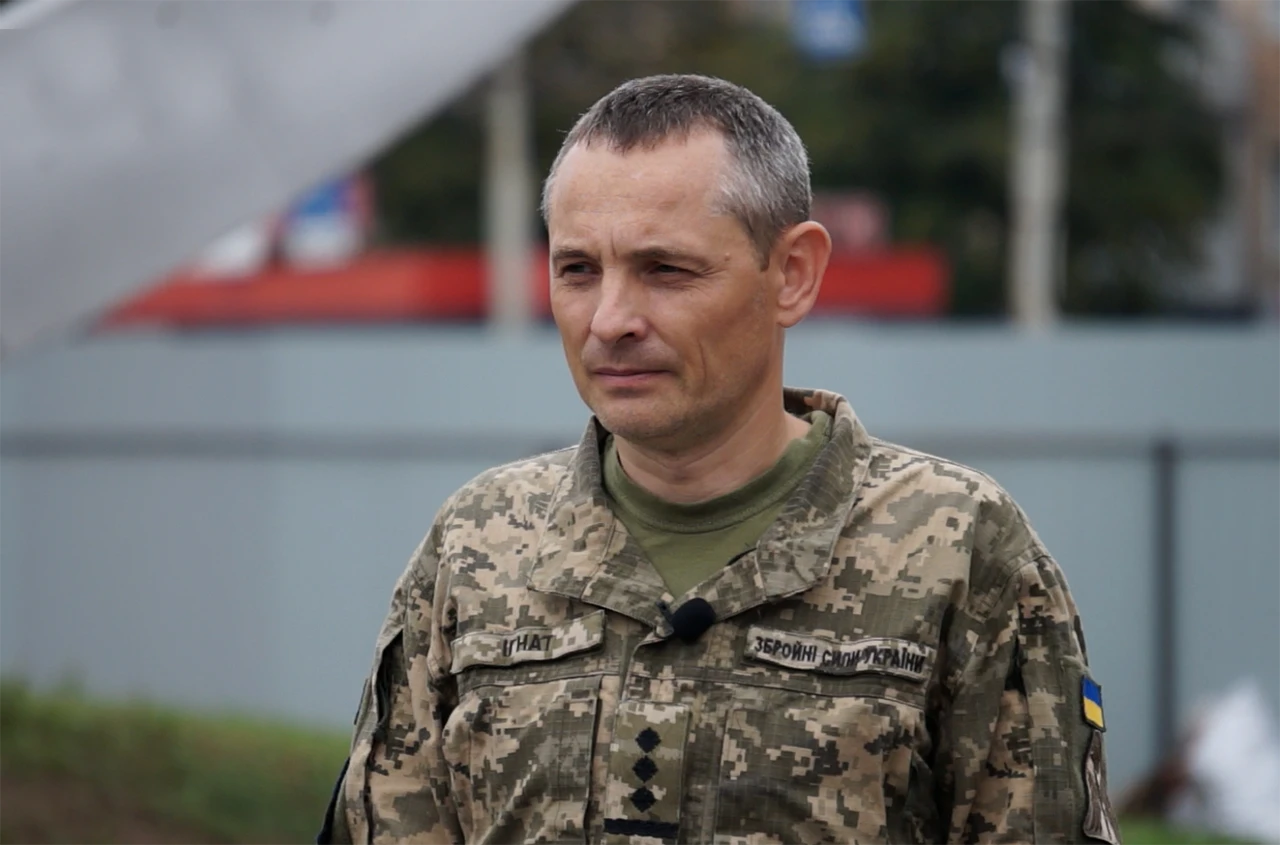
Yuriy Ihnat, spokesperson for the Air Force Command of the Ukrainian Armed Forces.
Photo: Suspilne
"When we have F-16s, we will win this war. If these aircraft come to Ukraine, they will be on combat duty in different regions at our operational airfields. With this fighter aircraft, the effectiveness of HARM missiles, JDAM guided bombs, and so on will increase significantly. The F-16 will help our ground troops quickly de-occupy Ukrainian territories by striking enemy command posts, military groups, and logistics supply chains. These fighter jets are also capable of restoring order at sea, having anti-ship missiles. The F-16 is a multi-purpose aircraft that can engage ground, air and surface targets, as it is equipped with Harpoon missiles," Ihnat emphasized.
- News














































